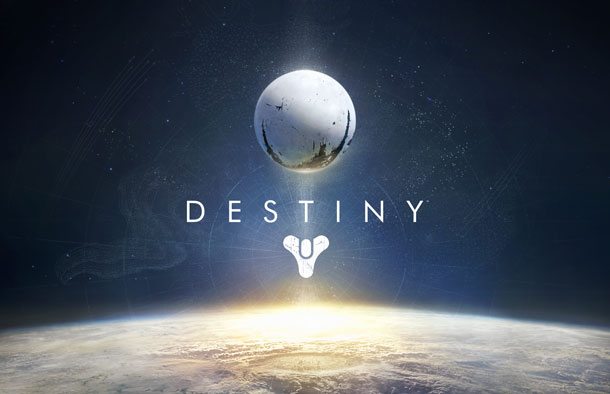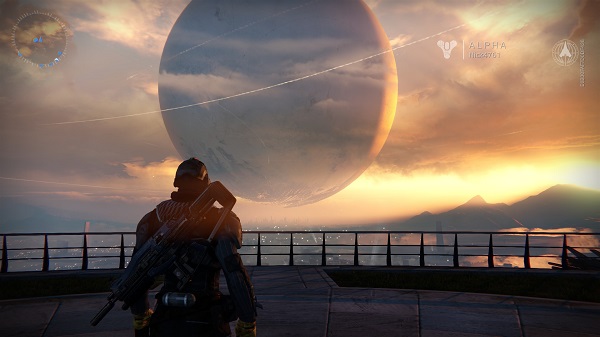So, Destiny is finally out. It’s kind of a big deal. It also clearly illustrates one way in which the Internet is forcing websites to change the way they review games.
I’ve always said that one of the ways I see games journalism developing is that it will increasingly move its emphasis away from news and reviews, and more towards more analytical and investigative content, simply because the Internet has greatly diminished the importance of the release-window review. Sure, some publishers still cling to the Almighty Metacritic like particularly desperate and unobservant limpets, but the truth is that with the rise of streaming consumers can actually watch any game they’re interested in being played and make their own decisions, and it’s a common sight now to see news of a game’s quality leak out on your NeoGAFs and Reddits days before its press embargo is lifted.
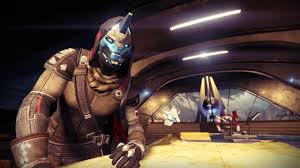 There’s also the fact that more games are, like Destiny, adopting the MMO model of persistent, always-online game worlds, something that also makes the viability of the advance review copy increasingly redundant. Bungie announced a few days ago that review copies of the game would be sent out only a day before the full release. While this is a traditional tactic used in several media when a publisher or company have little faith in their product (prompting many to speculate about the quality of the game), Bungie’s reasoning was that they would rather reviewers took some time to play the game in its full and active state rather than rush through the content on mostly empty servers, and therefore not getting the ‘true’ experience the developers intended.
There’s also the fact that more games are, like Destiny, adopting the MMO model of persistent, always-online game worlds, something that also makes the viability of the advance review copy increasingly redundant. Bungie announced a few days ago that review copies of the game would be sent out only a day before the full release. While this is a traditional tactic used in several media when a publisher or company have little faith in their product (prompting many to speculate about the quality of the game), Bungie’s reasoning was that they would rather reviewers took some time to play the game in its full and active state rather than rush through the content on mostly empty servers, and therefore not getting the ‘true’ experience the developers intended.
A bit precious? Maybe, but there’s some logic there. As more and more games use this kind of massively multiplayer model, it’s become increasingly difficult to review them for the reasons above. Generally publishers will set up servers specifically for reviewers, or give them early access to the public ones before release, which makes for a smooth gameplay experience but doesn’t actually tell you how hardy those servers are (Case in point: the Battlefield 4 fiasco). So there’s something to be said for foregoing the ‘me first’ mania that normally dominates the posting of reviews, taking it a bit more slowly and actually judging your opinions on the experience your audience is getting too.
So for Destiny we’re going to try something a little different. Instead of doing a standard review, I’m going to post some somewhat-organized impressions of the game today and again in two weeks, and see how it pans out. I know a lot of you guys will be deep in this game too, so it’ll be interesting to see how similarly (or otherwise) your opinions develop too.
It also means I have an excuse to not think up a score, which suits me the fuck fine.
RELEASE DAY: LEAPING INTO THE UNKNOWN (AND A LOT OF KNOWN) WITH A LANNISTER IN MY POCKET
Thanks to the ‘Alpha’ and ‘Beta’ (C’mon, we all know they were demos) there are certain fundamentals we know from the start: the shooting is extremely solid, the art direction and sound design is top-notch and the loot, from the limited slice we saw, strikes a nice balance between commonness and usefulness. The question now is how this all works as a full game.
This first day has reinforced just how fun Destiny is to play. It’s a blast and addictive as all hell, but it’s also raised a few flags that may end up calling its long-term appeal into question.
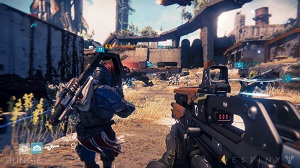 To be honest, I only gave the Beta a cursory run-through as it was immediately apparent that it was mostly rehashing the content we already saw in the Alpha, and I decided to back off to prevent burnout when the full game arrived. It didn’t take long for me to be glad of that choice. The initial Earthbound missions play out pretty much exactly as they did in the Beta, though it’s immediately apparent is how smoothly everything runs. No lag to be seen, one brief dropout and not much more reported so far – not bad for a worldwide launch, especially one getting this much attention. Thankfully, Bungie’s decision to set up local servers in Australia does a lot to ease the mind (Hey, we don’t get this very often!). It’s just a shame then that the first couple of hours of the game involves replaying the same missions we already know from the Alpha and Beta, though even then the game’s playability cuts through the repetition enough so that it isn’t a major problem.
To be honest, I only gave the Beta a cursory run-through as it was immediately apparent that it was mostly rehashing the content we already saw in the Alpha, and I decided to back off to prevent burnout when the full game arrived. It didn’t take long for me to be glad of that choice. The initial Earthbound missions play out pretty much exactly as they did in the Beta, though it’s immediately apparent is how smoothly everything runs. No lag to be seen, one brief dropout and not much more reported so far – not bad for a worldwide launch, especially one getting this much attention. Thankfully, Bungie’s decision to set up local servers in Australia does a lot to ease the mind (Hey, we don’t get this very often!). It’s just a shame then that the first couple of hours of the game involves replaying the same missions we already know from the Alpha and Beta, though even then the game’s playability cuts through the repetition enough so that it isn’t a major problem.
Levelling seems a little slower now, though it remains to be seen how the low-sounding level cap of 20 may affect the later stages of the game. The sense of constant progression is key to games like this – it’s why we have systems such as Call of Duty‘s Prestige and Diablo‘s Paragon levels – and the concern remains that if we hit it too soon it may undercut the motivation to play through the content. The game’s rather sparse loot system remains a mixed bag: while its comparative rarity lessens the need to sift through reams of junk items, it at this stage still seems to consist of weapons types that all basically look and feel the same only with different colour schemes and better numbers attached to them. Maybe we’ve all been spoiled by Borderlands, but a bit more diversity in the weapons would be a good thing to see as the game goes on.
The game feels slightly more difficult than in the previews, with several early encounters seeming to take more attempts to get through, and it occurs that the game uses the ‘encroaching darkness’ mechanic – which disables instant respawns and sends you back to the last checkpoint on death – very often. This I’m currently on two minds about: while a bit of challenge is always welcome, it feels at times like it’s intended to artificially inflate the difficulty and force level grinding to make you catch up to where the game thinks you should be. It feels slightly cheap at times, but may also just be a symptom of being low-level and not having had time to develop all your abilities.
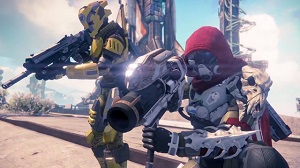 I wonder the same about the perk system, which follows the same fairly linear path as seen before, which so far has been a little dull. It’s sequenced in a way so that one perk unlocks at a time Diablo-style, but in the early stages at least lacks that franchise’s customizability. It’s been very much a case of ‘level up, click the perk the menu tells you to, move on’ and it’d be nice to see some more meaningful customization options come in later on.
I wonder the same about the perk system, which follows the same fairly linear path as seen before, which so far has been a little dull. It’s sequenced in a way so that one perk unlocks at a time Diablo-style, but in the early stages at least lacks that franchise’s customizability. It’s been very much a case of ‘level up, click the perk the menu tells you to, move on’ and it’d be nice to see some more meaningful customization options come in later on.
The good news is that the gunplay is just as good as before. Movement is smooth and responsive, the auto-aiming isn’t excessively noticeable but still allows for the odd cinematic bout of snap-aim marksmanship, and the guns, while lacking in variety, all feel solid and well-balanced. Unfortunately though, the AI is still a bit ropey, vacillating between spotting you from a mile off and standing around utterly oblivious to you until you get within yards of it. The level design is a mixed bag as well: everything’s insanely pretty and wonderfully designed, with escape and flanking routes in most cases easily accessible, yet on the other hand its multitude of secret little nooks and crannies feel underused in Story Mode. you’re constantly coming across caves and rooms that look like they should have something in them, and most likely do in free-roam – but are essentially superfluous dead space in the campaign, which conspires with the already restricted play areas to create a series of beautiful, panoramic spaces that look like they should have more stuff in them than they actually do.
Lore-wise, Destiny seems to follow the Bungie formula to a tee: sci-fi with quasi-mystical overtones, masked protagonists and uniform, hive-minded enemies. We know that Mankind is being protected by a giant alien ping-pong ball called the Traveller, that the Guardians wield a power known as The Light, that several alien races are vying to claim the Earth and that we have to find a way to stop a mysterious, encroaching menace called the Darkness.
Don’t expect much more information than that, at least so far; Bungie being Bungie, much of the heavy lifting of the game’s worldbuilding is done by the (admittedly incredible) art direction, with actual story information delivered with the mixture of mush-mouthed mysticism and Mystery Box-like fetishization of detail avoidance they perfected with the Halo series.
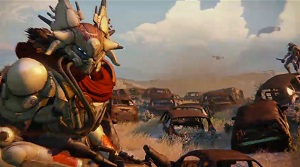 While Bungie have at least improved their character design in that you can actually see your Guardian’s face from time to time (At least when you’re in the Tower) the enemies also feel ripped straight from the Halo playbook, Needler-esque weapons and all. You always want to make sure your antagonist has a ‘face’, something with which Bungie have traditionally struggled. While the Fallen, the Hive and the Darkness aren’t quite cyphers it would be nice to see Bungie lift the veil enough so that we know a bit more about why these guys are the enemy. All we really have to go on is that the Fallen want to conquer the Earth, the Hive are enemies because they… come from the moon?.. and the Darkness’s motivation is apparently ‘Woohoo Mystery Box’. Sure, there’s nothing wrong with creating a bit of mystery, but Bungie have a tendency to put more effort into hyping their own lore than into making the it stand out in any meaningful way on its own merits, and this first good look at Destiny suggests that it may be business as usual writing-wise. hopefully the late-game will give some more solid exposition instead of telling us over and over how mysterious and portentous everything is without really giving us much clue as to what anything actually is.
While Bungie have at least improved their character design in that you can actually see your Guardian’s face from time to time (At least when you’re in the Tower) the enemies also feel ripped straight from the Halo playbook, Needler-esque weapons and all. You always want to make sure your antagonist has a ‘face’, something with which Bungie have traditionally struggled. While the Fallen, the Hive and the Darkness aren’t quite cyphers it would be nice to see Bungie lift the veil enough so that we know a bit more about why these guys are the enemy. All we really have to go on is that the Fallen want to conquer the Earth, the Hive are enemies because they… come from the moon?.. and the Darkness’s motivation is apparently ‘Woohoo Mystery Box’. Sure, there’s nothing wrong with creating a bit of mystery, but Bungie have a tendency to put more effort into hyping their own lore than into making the it stand out in any meaningful way on its own merits, and this first good look at Destiny suggests that it may be business as usual writing-wise. hopefully the late-game will give some more solid exposition instead of telling us over and over how mysterious and portentous everything is without really giving us much clue as to what anything actually is.
Although I’ve focused on the nitpicks here, it also can’t be denied that my first day with Destiny has been an enjoyable experience. Bungie prove again their mastery at delivering that thirty seconds of fun over and over again, and few in the industry can match them for sheer production value (That glorious music!). But then again, the Alpha and Beta already sold us on that stuff: what Destiny needs to show now is that it has the legs to sustain its audience past the initial rush. However, there’s a long way to go yet – we’ll see in a couple of weeks how the late-game content stacks up.
This article is based on a purchased release copy of Destiny.
